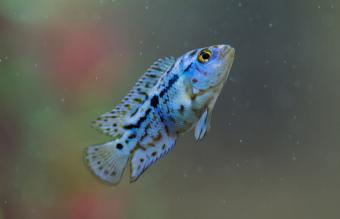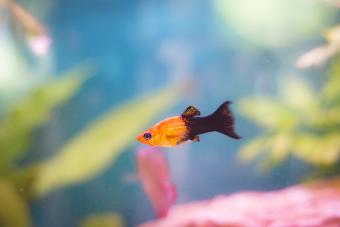
Carnivorous fish thrive on protein-packed meals, munching on everything from insects and crustaceans to sometimes even smaller fish. This kind of diet is super important for them — it's what keeps them growing strong, healthy, and full of energy. In the aquarium world, enthusiasts are known to love keeping meat-eating fish. They're popular not only for what they eat but also for their fascinating behaviors.
Caring for Carnivorous Fish
While caring for many of the more popular carnivorous fish isn't that difficult or different from other fish, there are some key things you need to be aware of to take care of them properly. It's important to research each carnivorous species' specific requirements before adding them to your aquarium.
Factors like tank size, water requirements, and compatible tankmates are important to look at before bringing them home. You want to ensure they have a healthy and thriving environment. It's also essential to understand their feeding patterns and nutritional needs to maintain their health and prevent overfeeding, which can lead to water quality issues.
What Most Carnivorous Fish Eat
Some carnivorous fish eat live food like small feeder fish, brine shrimp, bloodworms, crickets, mealworms, and snails. Others will eat the same in frozen form or a mix of the two. You can also purchase pellets and flakes designed for carnivorous fish. Most fish do well with a diet consisting of the three options to provide variety. What one meal doesn't provide them with, the other should.
Beware of Feeder Fish
Be careful when using feeder fish, as they frequently harbor diseases and may not be in the best health. It's important to buy them from a reputable source that offers healthy fish. Alternatively, you could consider breeding your own feeder fish. However, keep in mind that this requires extra effort and will incur additional costs.
If you feed brine shrimp instead of feeder fish, you can purchase live ones from a pet store or raise your own very simply and cheaply using a hatchery.
Carnivorous Fish Tank Mates
Some carnivorous fish can live peacefully with other species, while others cannot. Make sure that you research your fish before putting them in a community tank. For example, bettas can live with smaller, peaceful schooling fish and with female bettas, but you can't put two males together. On the other hand, the oscar can only live safely with other oscars.
Some carnivorous fish will eat other fish you place in the tank if they're small enough. Others will ignore smaller fish if the tank they live in is large enough to accommodate everyone. Overpopulation is a serious issue for any fish, so whether you have carnivorous fish or not, make sure you give fish enough room to swim freely.
If you're not sure which fish will work with your carnivores, consult your local fish specialty shop staff for advice.
Common Carnivorous Pet Fish
There are several species of carnivorous fish that are easily obtained from a pet or fish specialty store (you may even be able to adopt them from a shelter). Each fish species has its own specific dietary needs.
Inexperienced sellers may not provide enough information about the carnivorous fish they sell, so you may not even know they're carnivorous without doing your own digging.
The Elegant Angelfish

These graceful and lovely fish are actually omnivorous, although they tend to rely more on eating as carnivores in their natural environment.
Tankmates for the Angelfish
Angelfish will eat smaller fish in a tank, such as tetras, and do best in a tank with other angelfish or in a tank large enough that smaller fish can be safe.
Feeding Your Angelfish
Angelfish should eat a diet of species-appropriate flakes and pellets, as well as brine shrimp and mosquito larvae. These can be live, freeze-dried, or frozen.
The Vibrant Betta Fish

The beautiful Betta, also known as the Siamese fighting fish, is considered a carnivore, although they can live on an omnivorous diet.
Tankmates for Betta Fish
Bettas can live with other fish as long as they are smaller and more peaceful with less impressive fins, such as corydoras, tetras, and plecos. Males cannot live with other male bettas, however.
Feeding Your Betta
They should be fed a diet of commercially made pellets or flakes made for bettas, frozen or live bloodworms, and brine shrimp.
The Aggressive Cichlid (Jack Dempsey)

While many cichlid species are omnivorous, the Jack Dempsey cichlid is most definitely a carnivore. Because of their temperament, Jack Dempsey fish are not a good choice for the beginner fish keeper. They are also known for being aggressive and territorial, and they will most definitely eat smaller fish.
Tankmates for Your Cichlid
They do best with tank mates of similar size and temperament, as they're less likely to bully a fish too large to eat and with a similar attitude. Good choices are angelfish and some other cichlid species.
The larger your tank, the less likely aggression is to occur.
Feeding Your Cichlid
Jack Dempsey fish will eat a mix of pellets and flakes made for cichlids, along with live bloodworms, brine shrimp, crickets, snails, and small feeder fish.
The Colorful Discus

These colorful, round-shaped fish are best kept with intermediate to experienced fish lovers as they have very specific water needs. While they can eat plant matter, discus are primarily carnivorous.
Discus Tankmates
Discus are peaceful fish who will not eat other fish and, in fact, should not be paired with aggressive species as they're likely to get bullied and hurt. They can live well with gouramis, tetras, and some corydoras.
Discus Fish Diet
In addition to providing them with plant food like algae and spirulina, they can also eat insects, crustaceans, amphipods, and copepods. They will enjoy live mosquito larvae, brine shrimp, bloodworms, and even chopped-up beef hearts.
The Small Killifish

There are more than 700 species of these small, colorful fish, which are considered intermediate-level fish to keep because of their personality and diet.
Killifish Tankmates
Killifish can be housed with their own species, but males can be aggressive to other males as well as to male fish of other species that are of a similar size and shape. You can have multiple females in one tank, and they can live peacefully with many types of tetras.
Feeding Your Killifish
Killifish need to eat live food and do not do well on flakes or pellets, which makes keeping them more difficult. The cheapest way to keep killifish is by raising their food yourself, although this will take more time and effort, and some types will have to be purchased from a supply store. They typically eat brine shrimp, daphnia, mosquito larvae, tubifex worms, black worms, white worms, fruit flies, and beef hearts.
The Hungry Oscar

The oscar is a highly intelligent fish that is generally kept in a tank with other oscars. They are considered to be omnivorous, but they are primarily carnivorous in the wild.
Tankmates for Oscar Fish
While they are best living with other oscars, you can put them in a large community tank with peaceful fish of the same size as other cichlids, arowanas, and plecos.
Feeding Your Oscar
Generally, they can be fed flakes and pellets made for cichlids and enjoy live and frozen brine shrimp, daphnia, and bloodworms. They will also eat shrimp and snails if they're placed in the tank.
Oscars are likely to eat other fish in a community tank if they're small enough.
The Adorable Pea Puffer

This cute little fish is primarily carnivorous and best with intermediate-to-experienced fish owners. Despite their tiny size, the males are aggressive towards other males, and you can only keep one male in a tank, but more than one female is fine.
Pea Puffer Tankmates
Pea puffers do best in a puffer-only tank, but if you have a large enough community tank, they can live with smaller schooling fish like tetras, danios, barbs, and rasboras.
Feeding Your Pea Puffer Fish
Pea puffers need a diet with a small amount of algae and the rest consisting of protein. They will eat larvae, copepods, fleas, insects, bloodworms, and brine shrimp. These can be live or frozen. They will also eat small snails and shrimp species placed in the tank.
Keeping Carnivorous Fish As Pets
While the term might make you think carnivorous fish are all aggressive and hard to keep, there are many popular aquarium fish that are carnivorous and suitable for beginners. Some have more specific care requirements that might make them better choices for more experienced owners, but with enough research, even a beginner can successfully tackle the care of carnivorous fish with more needs, like discus, Jack Dempsey, and killifish.







